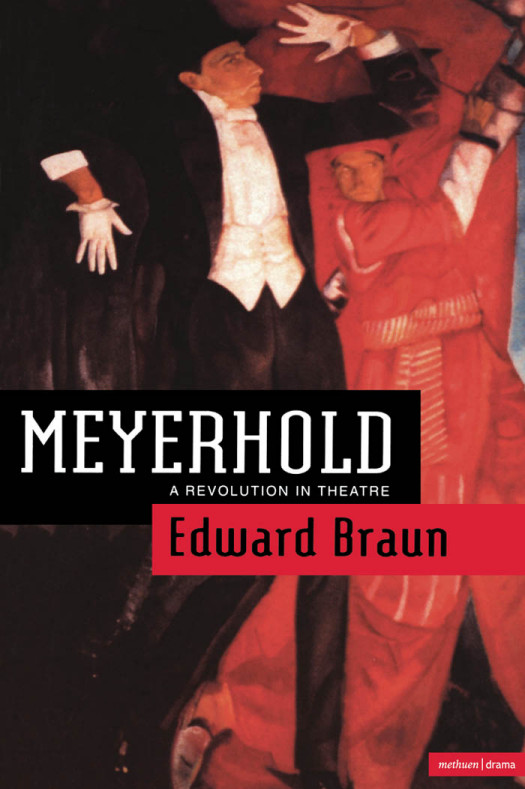Edward Braun: Meyerhold: A Revolution in Theatre (1979/1995)
Filed under book | Tags: · art, biography, biomechanics, constructivism, epic theatre, history of theatre, proletkult, revolution, symbolism, theatre

“Legendary Russian theater director Vsevolod Meyerhold (1874-1940) led the revolt against naturalism and flouted Stalinist socialist realism with his avant-garde productions incorporating mime, constructivist sets, musical scores and formalized scenery. His scenic invention and use of cinematic techniques culminated in his 1926 staging of Gogol’s The Government Inspector as well as reinterpretations of classics such as Pushkin’s Queen of Spades. Braun, a drama professor in England, sees Meyerhold as a supreme director-poet for whom the theater was designed to shatter the audience’s complacency. Decked out with 145 photographs of set reproductions, costumes and posters, Braun’s vibrant study restores Meyerhold’s radical legacy for contemporary theater. This revision of a work first published in 1979 draws on a wealth of newly discovered writings by Meyerhold, as well as KGB files released since 1989 that tell the full story of the director’s arrest, torture and execution after being falsely labeled a foreign agent by Stalin.” (Source)
Originally published in 1979
Second, revised and expanded, edition
Publisher Methuen Drama, 1995
ISBN 0413727300
347 pages
Reviews: Sharon Marie Carnicke (Modern Drama, 1996), Christine Kiebuzinska (Theatre Journal, 1996), Phil Shannon (Green Left Weekly, 1999).
PDF (33 MB)
Comment (0)Mark Rothko: The Artist’s Reality: Philosophies of Art (2004)
Filed under book | Tags: · abstraction, art, art theory, beauty, colour, environment, light, myth, painting, philosophy of art, reality, renaissance, representation, space, symbolism

“One of the most important artists of the twentieth century, Mark Rothko (1903–1970) created a new and impassioned form of abstract painting over the course of his career. Rothko also wrote a number of essays and critical reviews during his lifetime. Although the artist never published a book of his views, his heirs indicate that he occasionally spoke of the existence of such a manuscript to friends and colleagues. Stored in a New York City warehouse since the artist’s death more than thirty years ago, this manuscript, titled The Artist’s Reality, is now being published for the first time.
Probably written around 1940–41, this book discusses Rothko’s ideas on the modern art world, art history, myth, beauty, the challenges of being an artist in society, the true nature of “American art,” and much more. The Artist’s Reality also includes an introduction by Christopher Rothko, the artist’s son, who describes the discovery of the manuscript and the process of bringing it to publication. The introduction is illustrated with a small selection of relevant examples of the artist’s own work as well as with reproductions of pages from the actual manuscript.”
Edited and with an Introduction by Christopher Rothko
Publisher Yale University Press, 2004
ISBN 0300115857, 9780300115857
136 pages
R. Bruce Elder: Harmony and Dissent: Film and Avant-garde Art Movements in the Early Twentieth Century (2008)
Filed under book | Tags: · abstract cinema, art history, avant-garde, cinema, colour, constructivism, dissent, experimental film, film, film history, film theory, marxism, modernism, music, occultism, productivism, revolution, suprematism, symbolism, theology

“R. Bruce Elder argues that the authors of many of the manifestoes that announced in such lively ways the appearance of yet another artistic movement shared a common aspiration: they proposed to reformulate the visual, literary, and performing arts so that they might take on attributes of the cinema. The cinema, Elder argues, became, in the early decades of the twentieth century, a pivotal artistic force around which a remarkable variety and number of aesthetic forms took shape.
To demonstrate this, Elder begins with a wide-ranging discussion that opens up some broad topics concerning modernity’s cognitive (and perceptual) regime, with a view to establishing that a crisis within that regime engendered some peculiar, and highly questionable, epistemological beliefs and enthusiasms. Through this discussion, Elder advances the startling claim that a crisis of cognition precipitated by modernity engendered, by way of response, a peculiar sort of “pneumatic (spiritual) epistemology.” Elder then shows that early ideas of the cinema were strongly influenced by this pneumatic epistemology and uses this conception of the cinema to explain its pivotal role in shaping two key moments in early-twentieth-century art: the quest to bring forth a pure, “objectless” (non-representational) art and Russian Suprematism, Constructivism, and Productivism.”
Publisher Wilfrid Laurier University Press, Waterloo, 2008
ISBN 1554580285, 9781554580286
480 pages
Review: David Sterritt (Quarterly Review of Film and Video, 2011).
PDF (updated on 2019-12-14)
Comments (7)
